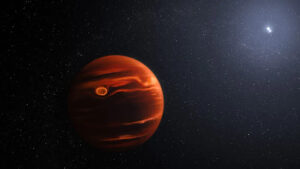NASA’s James Webb Space Telescope (JWST) has made a groundbreaking discovery by capturing the distinct signature of water, along with evidence for clouds and haze, in the atmosphere of an exoplanet.
The telescope’s ability to detect infrared wavelengths allows it to fingerprint chemicals such as water and methane present in the atmosphere of these distant worlds. This discovery has significant implications for our understanding of exoplanets and the search for potentially habitable environments beyond our solar system.
Webb’s Infrared Capabilities
The JWST is a powerful space observatory that was specifically designed to study the universe in infrared wavelengths. By observing in this part of the spectrum, Webb can penetrate the dust and gas that often obscure visible light, revealing hidden features of celestial objects.
This makes it an ideal tool for studying the chemical composition of exoplanet atmospheres, as it can detect the unique spectral signatures of various molecules, including water and methane.
A World With Water and Methane
The recent detection of water and methane in the atmosphere of an exoplanet is a remarkable achievement for the JWST. Water is a key ingredient for life as we know it, and its presence on an exoplanet raises exciting questions about the potential for habitability.
Methane, on the other hand, is closely associated with metabolic processes in Earth’s biosphere, making its detection on an exoplanet particularly intriguing . The presence of both water and methane in the atmosphere of this distant world suggests that it may have a complex and dynamic environment, worthy of further study.
Implications for Exoplanet Research
This groundbreaking discovery by the JWST has important implications for our understanding of exoplanets and the search for life beyond Earth. By characterizing the atmospheres of these alien worlds, we can gain valuable insights into their potential habitability and the conditions under which life might thrive.
Furthermore, the detection of biosignature gases, such as methane, could provide indirect evidence for the presence of biological activity on these distant planets.
The James Webb Space Telescope’s detection of water and methane in the atmosphere of an exoplanet marks a significant milestone in our exploration of the universe . This discovery not only expands our knowledge of the diverse environments that exist beyond our solar system but also brings us one step closer to answering the age-old question of whether we are alone in the cosmos.
As we continue to probe the atmospheres of other worlds with the JWST, we can anticipate many more exciting discoveries that will undoubtedly reshape our understanding of the universe and our place within it.
References:
NASA’s Webb Reveals Steamy Atmosphere of Distant …
The Five Big Ways the James Webb Telescope Will Help …
JWST Heralds a New Dawn for Exoplanet Science


